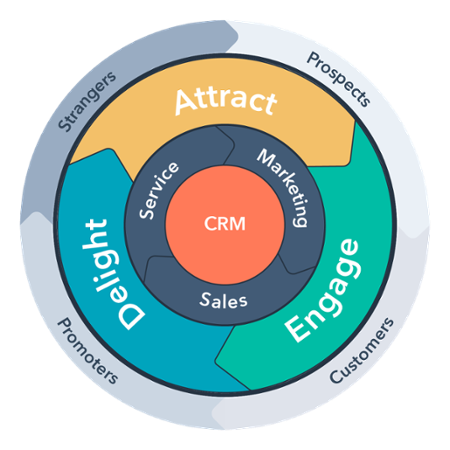HubSpot Launches Service Hub Following Impressive Q1
By Laura Myers
May 17, 2018
B2C, customer engagement, customer experience, Customer Journey, Customer Service, Hubspot, marketing, marketing technologies, martech, sales, sales cycle
Perhaps one of the most widely used quotes from the famed show Mad Men is “if you don’t like what’s  being said, change the conversation” but what if you like what’s being said, and rather than change the conversation, you take that conversation and use it to change your business? This is what recently happened with HubSpot.
being said, change the conversation” but what if you like what’s being said, and rather than change the conversation, you take that conversation and use it to change your business? This is what recently happened with HubSpot.
What started as an ‘ah-ha’ moment for their Chief Executive Officer, Brian Halligan went on to show a spike in total sales for the sales and marketing platform in Q1 and inspire the release of their new Service Hub, which is designed to take over where the common acquisition funnel may be failing, with the need best described by Hubspot's Chief Operating Officer JD Sherman: “Your biggest untapped growth opportunity today is in fact your existing customers. With Service Hub, we’re giving business the tools they need to tap into that opportunity.”
HubSpot is Now in the Services Business
HubSpot’s CEO did something really valueable here in my opinion. Upon the release of their new offering, he took to LinkedIn to explain his thought process and the main driving factors behind this new strategy for HubSpot. Great nod to the value of transparency in an organization.
In short, he found his perspective had changed from seeing his business as a standard sales and marketing funnel to a flywheel with a spin fueled by customer delight creating a momentum that was drawing in prospects. To bookend this newfound view, Halligan also humbly explained how his perception of their own sales and marketing strategies having the ‘loudest voice in the market’ was changing and in its place came the realization the voice of their customers had now taken its place.
He explains it was all driven by his recognition of the parallel shifts not only in how purchasing decisions are made but the dramatic change in people’s expectation of service over the last few years. As resistant as some can be to personalization, if their online research phase doesn’t offer the satisfactory answers they need relating to a business, there is a definite expectation placed on the engagement of a brand in conversation that the person they speak with will know a customer's history with the business and have a tailored answer on hand to alleviate all of their woes.
Those fuzzy feelings offered to customers don’t happen easily though, there are a lot of moving parts that have to be working seamlessly to achieve this level of expected experience and that is the need Halligan explained their modern customer service system, built in HubSpot's Dublin office would address: 
“Building a modern system that enables a vendor to create that modern service experience is very complicated. To do it right, you’d need a knowledge base system, an SEO system so those knowledge articles could get found in Google, a chat system for your website, a messaging system for Facebook, a bot builder, a ticketing system, an Net Promoter Score system, and a customer marketing system and all that would need to constantly sync with your CRM system. All very doable if you’d like to buy 8 systems, pay 8 bills, and learn 8 user interfaces. But, it’s just too painful for a small or medium sized business to pull this off today.”. Here again is an example of HubSpot never leaving the SMBs behind that helped to get the organization to where it is today.
Service Hub and the New Inbound Service Framework
After a recognition described by Sherman that many support products on the market today were missing the mark in their singular focus of cost reduction, HubSpot wanted to design a system for organizations to be able to view service as the huge growth opportunity it could be with the right tools in place. How this works, is in combination with the Marketing Hub and Sales Hub, customer data would be integrated with lead and deal data in a brand new way giving teams in marketing, sales and services a complete end to end picture of a customer’s interactions with the company, allowing a collaboration effort to be achieved in addressing and resolving an issue a customer may be facing quicker and more efficiently.
The individual component products that make up the Service Hub as a whole were designed to arm service teams with what they needed to efficiently manage even the most impatient customer seeking the highest level of speed and convenience:
- Conversations – A universal inbox that unites messages across chat, email, and other channels to help team collaborate and enable customers to engage with companies however they want.
- Tickets – A CRM object to track, record, and organize customer needs.
- Automation – Platform-level automation that uses workflows to route Tickets and create a help desk.
- Knowledge Base – A tool that helps you create simple well-structured help articles from templates that automatically index on Google search and a reporting dashboard.
- Customer Feedback – A tool featuring guided survey creation, feedback collection, and audience insights analytics.
- Reporting – A new service dashboard featuring reports on how your team is handling tickets, how customers are sharing feedback, and the efficacy of your Knowledge Base.

As an added value, Michael Redbord, the man behind HubSpot’s own customer support team growing from 0-250 in the last seven years, created a new inbound service framework to truly give users the power to take conversion one step further, taking customers and turning them into promoters. This is done by helping businesses to:
- Engage more customers in meaningful interactions across different channels with Conversations.
- Stay organized and meet customer expectations with Tickets.
- Guide customers with proactive solutions like Knowledge Base.
- Grow their relationship with customers by listening and understanding their needs with Customer Feedback.
“As the leader of a customer service team, I personally experienced the challenges that stem from not having a unified, scalable system in place. The simplest of tasks were slow and inefficient, and our customers felt that,” said Redbord. “I brought that knowledge to the table when we set out to build Service Hub. The result is a product I wish I had when I was in that customer service role myself. I’m proud of what the team here has accomplished, and can’t wait to see our customers achieve success as well.”
HubSpot Laser-Focused on R&D
It’s clear as well that HubSpot will be rolling out far more innovation where these new releases are coming from since their CEO let everyone know on a recent analyst earnings call they will start focusing more on R&D spend to create new products, I assume to satisfy the needs of customers with this new perspective and less on sales and marketing. This shift is already apparent in their first quarter with R&D spending taking a jump of 97% compared to last year.
This change is just the tip of the Q1 iceberg though for HubSpot starting with their total sales spiking 39% in the quarter to $114.6 million, surpassing even the lofty expectation the company’s own revenue guidance by more than $4 million. The factors they found contributed to this pleasant underestimation is the combination of expanding subscription sales alone up 40% from 2017 and professional services sales combined with other revenue jumping up 25% over Q1 2017.
Some more highlights of their Q1 results are:
- Sales from the company's international customers climbed 67% year over year and represented 36% of revenue in the first quarter
- The company ended the first quarter with 44,894 total customers, which was up 44% year over year. The average subscription revenue per customer was $10,016.
- The company's R&D spending reached $26.3 million in the quarter, up from $13.3 million in the year-ago quarter.
- The company generated $17.9 million of free cash flow, which was an increase from the $11.6 million in the first quarter of 2017.
Ending Notes
This success for me goes to show they have not only recognized the value for other businesses to leverage their existing customer base, but the value HubSpot can mine out of its own customer base with the higher ROI to back it up beginning to emerge first-hand in Q1 with I am sure more proof on the way in Q2.
Putting a better services experience in the hands of their customers at a more budget friendly cost than the numerous systems they would need to employ is helpful as well. Many businesses proclaim they don’t have the budget for better customer service but in my opinion, businesses can’t afford to have bad customer service, plain and simple. Given the way word of mouth good or bad spreads like absolute wild-fire in the age of online conversation, no one can underestimate what a bad customer service experience can mean for even one customer.
Steven Loepfe, founder and managing partner of Storylead, a beta user of Service Hub and HubSpot Gold Tier Partner touched on this point as well when he said “Some clients say that they don’t have the budget for more customer service, but that mindset needs to change. When you add value for customers, you simultaneously grow your own business, as an agency, the majority of our revenue comes from returning customers and their referrals. Service Hub is exactly what we’ve been looking for. Our clients already use HubSpot, so this will be a natural step for them. It’s a huge opportunity, for us and for them.”
Finally, the shift from funnel to flywheel by Halligan is such a fantastic analogy to use because truly, funnels give the idea of a beginning and an end which many know is becoming an archaic model, quickly getting replaced with something far more cyclical, where points of success are being fed back in and whats not working is being sifted out and over time the momentum of the business model is growing stronger and stronger.

Laura Myers
A digital business, marketing and social media enthusiast, Laura thrives on asking unique, insightful questions to ignite conversation. At an event or remotely, she enjoys any opportunity to connect with like-minded people in the industry.